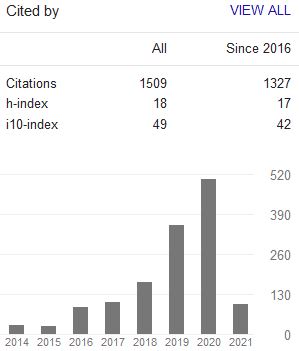Berkelakar and Directives in Palembang Malay: The Islamic Humor Discourse in Indonesia
Abstract
Keywords
Full Text:
PDFReferences
Aarons, Debra. “Puns and Ta cit Linguistic Knowledgeâ€. Salvatore Attardo (ed.). The Routledge Handbook of Language and Humor. New York: Routledge, 2017.
Afriani, Susi Herti. “Realisasi Strategi Kesantunan Direktif di dalam Bahasa Palembang (Baso Pelembang) di Kalangan Anggota Kelompok Extnis Palembang di Kota Palembang: Sebuah Studi Sosial Budayaâ€. Paper presented at the Bahasa Ibu, Pelestarian dan Pesona Bahasanya. Bandung, 2014.
Afriani, Susi Herti. “The Realization of Politeness Strategies in English Directives among Members of Palembangnese Ethnic Groups in Palembang, South Sumatra, Indonesia: Teaching Journeyâ€. Istinbath 15, 1 (2015).
Alwi, Alhamdu. “Karakter Masyarakat Islam Melayu Palembangâ€. Psikoislamedia 3, 1 (2018).
Amin, Baderel Munir et al. Tata Bahasa dan Kamus Baso Palembang. Palembang: Yayasan Madrasah Najahiyah, 2010.
Badan Pusat Statistik Indonesia, Penduduk menurut Wilayah dan Agama yang dianut. https://sp2010.bps.go.id/index.php/site/tabel?tid=321&wid=0, accessed on 25 September 2019.
Bell, Nancy. Failed Humor. New York: Routledge, 2017.
Brown, Penelope and Stephen Levinson. “Universals in Language Usage: Politeness Phenomenaâ€. E. Goody. Questions and Politeness: Strategies in Social Interaction. Cambridge: Cambridge University Press, 1978.
Brown, Penelope and Stephen Levinson. Politeness: Some Universals in Language Usage. Cambridge: Cambridge University Press., 1987.
Chiaro, D. The Language of Jokes in the Digital Age: Viral Humor. Florence: Routledge, 2017.
Chlopicki, Wladyslaw. “Humor and Narrativeâ€. Salvatore Attardo (ed.). The Routledge Handbook of Language and Humor. New York: Routledge, 2017.
Dungcik, Mashyur. “Kewujudan Bahasa Melayu Palembang Ditinjau Berdasarkan Segitiga Semiotik Ogden dan Richards: Kajian Semantik Terhadap Kosa Kata dalam Kamus Baso Palembangâ€. Unpublished Ph.D Dissertation, University of Brunei Darussalam, 2017.
Dunggio, P. Struktur bahasa Melayu Palembang. Jakarta: Pusat Pembinaan dan Pengembangan Bahasa, Departemen Pendidikan dan Kebudayaan, 1983.
Ford, Cecilia and Barbara Fox. “Multiple Practices for Constructing Laughablesâ€. Prosody in interaction 23 (2010).
Fox, Richard. “Om Swasty-Alaikum… Interpreting Religio-Ethnic Humor on the Balinese Stageâ€. Archipel 86, 1 (2013).
Galinanes, Cristina Larkin. An Overview of Humor Theory. New York: Routledge, 2017.
Glenn, Phillip and Elizabeth Holt. “Conversation Analysis of Humorâ€. Salvatore Attardo (ed.). The Routledge Handbook of Language and Humor. New York: Routledge, 2017
Graf, Arndt. “Researching the Humorous in Indonesian Islamâ€. Orient. German Journal for Politics, Economics and Culture of the Middle East (2010).
Guidi, Annarita. “Humor Universalsâ€. Salvatore Attardo (ed.), The Routledge Handbook of Language and Humor. New York: Routledge, 2017.
Gunawan, Fahmi and Alimin. “Humor, Happiness and Work Relationship among Faculty Members in Islamic Higher Education of Indonesiaâ€. Langkawi: Journal of the Association for Arabic and English 4, 1 (2018).
Hamad, Ibnu. “Lebih Dekat dengan Analisis Wacanaâ€. MediaTor 8, 2 (2007).
Hanafiah, Djohan. Kuto Besak: Upaya Kesultanan Palembang Menegakkan Kemerdekaan. Jakarta: Haji Mas Agung, 1989.
Hempelmann, Christian. “Punsâ€. Salvatore Attardo (ed.), Encyclopedia of Humor Studies. California: Sage, 2014.
Hepburn, Alexa and Scott Varney. “Beyond (Laughter)): Some Notes on Transcriptionâ€. P. Phillip Glenn and Elizabeth Holt (eds.). Studies of Laughter in Interaction. Great Britain: Bloomsbury Academic, 2013.
Istiningtyas, Listya. “Humor dalam Kajian Psikologi Islamâ€. Jurnal Ilmu Agama UIN Raden Fatah 15, 1 (2014).
Jefferson, Gail. A Technique for Inviting Laughter and its Subsequent Acceptance/Declinationâ€. Everyday Language: Studies in Ethnomethodology (1979).
Jefferson, Gail. “On the Organization of Laughter in Talk about Troublesâ€. Structures of Social Action: Studies in Conversation Analysis (1984).
Jefferson, Gail. “An Exercise in the Transcription and Analysis of Laughterâ€. Teun Van Dijk (ed.). Handbook of Discourse Analysis. London: Academic Press, 1985.
Jefferson, Gail. “Sometimes a Frog in Your Throat is just a Frog in Your Throat: Gutturals as (Sometimes) Laughter-implicativeâ€. Journal of Pragmatics 42, 6 (2010).
Lesmana, Maman. “Teks-teks Humor Politik di Indonesia: Sekedar Hiburan atau Sekaligus Kritikan?â€. Susurgalur 2, 1 (2014).
Marwan, Iwan. “Rasa Humor dalam Perspektif Agamaâ€. Buletin Al-Turas 19, 2 (2013).
Raskin, Victor. Semantic Mechanisms of Humor. Boston: D. Reidel Pub. Co., 1985.
Renkema, Jan. Introduction to Discourse Studies. Philadelphia: John Benjamins Publishing Company, 2004.
Ridwan, Aang. “Humor dalam Tabligh Sisipan yang Sarat Estetikaâ€. Ilmu Dakwah 15, 5 (2010).
Rosadi, Andri. The Dynamics of Salafism in Pekanbaru: from Deprived Muslims to a Community of Memory. Western Sydney University Australia, 2019.
Rosenthal, Franz. Humor in Early Islam. Leiden-Boston: Brill, 2011.
Ross, Alison. The Language of Humor. London New York: Routledge, 1998.
Searle, John. Speech Acts: An Essay in the Philosophy of Language. London: Cambridge University Press, 1969.
Simpson, Paul and Derek Bousfield. “Humor and Stylisticsâ€. Salvatore Attardo (ed.). The Routledge Handbook of Language and Humor. New York: Routledge, 2017.
Sumadi. Islam dan Seksualitas: Bias Gender dalam Humor Pesantren. El-Harakah 19, 1 (2017).
Susilastri, Dian. et al., Kamus Palembang Indonesia. Second Edition. Palembang: Balai Bahasa Provinsi Sumatera Selatan, Badan Pengembangan dan Pembinaan Bahasa Kementerian Pendidikan dan Kebudayaan, 2013.
Tim Redaksi Kamus Besar Bahasa Indonesia. Kamus Besar Bahasa Indonesia (Big Dictionary of Indonesian Language. Jakarta: Balai Pustaka, 2002.
Trouvain, Jurgen and Khiet Truong. Laughter. New York: Routledge, 2017.
DOI: 10.15642/JIIS.2021.15.2.301-328
Refbacks
- There are currently no refbacks.
Indexed by:
Journal of Indonesian Islam (ISSN 1978-6301 and E-ISSN 2355-6994) is published by the Postgraduate Program (PPs) and the Institute for the Study of Religion and Society (LSAS), State Islamic University (UIN) of Sunan Ampel Surabaya.
Journal of Indonesian Islam by http://jiis.uinsby.ac.id/index.php/JIIs/index is licensed under a Creative Commons Attribution-ShareAlike 4.0 International License.
Copyright ©2020 State Islamic University (UIN) of Sunan Ampel Surabaya. Powered by Public Knowledge Project OJS.







